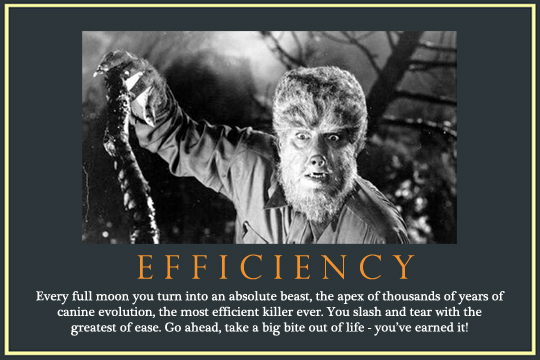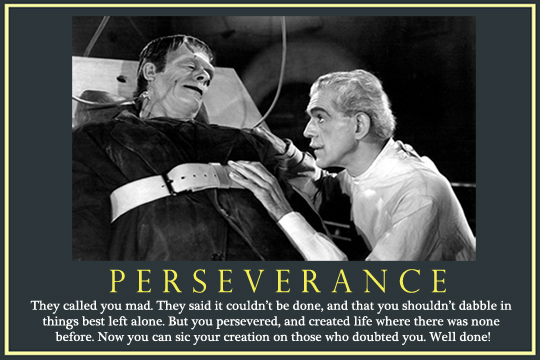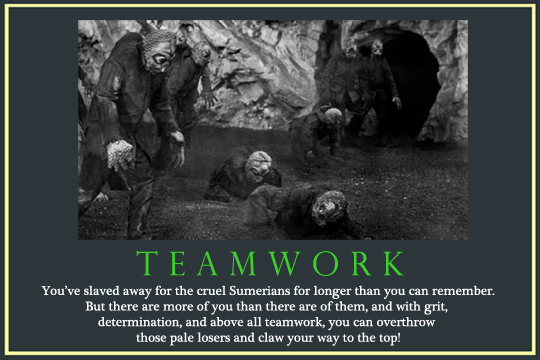Pros: Intriguing premise inspired by sci-fi pulp magazines; John Agar gets to laugh maniacally playing a scientist possessed by an evil alien brain
Cons: The production’s cheapness undercuts its lofty ambitions
This post is part of the fourth annual So Bad It’s Good blogathon hosted by brainy Rebecca at her Taking Up Room blog. Once you’ve checked out this entry, zip on over there for more takes on the art and entertainment of bad movies.
Ever since Fritz stole a diseased criminal’s brain to plop into the monster’s skull in the original Frankenstein, horror and sci-fi fans have had brains on the brain.
And who’s to blame them? Detached from its protective skull, the human brain is a disgusting, alien-looking thing, a rounded gelatinous mass of folds, fissures and crevices that looks like it's just waiting to launch itself at you and eat your face off.
Various versions of the Frankenstein story alone have put the brain front and center in pop horror culture. In Hammer’s Frankenstein series, after the Baron stitched together the horrific creature in Curse of Frankenstein, he learned his lesson in subsequent films and concentrated on transplanting brains between pre-owned bodies.
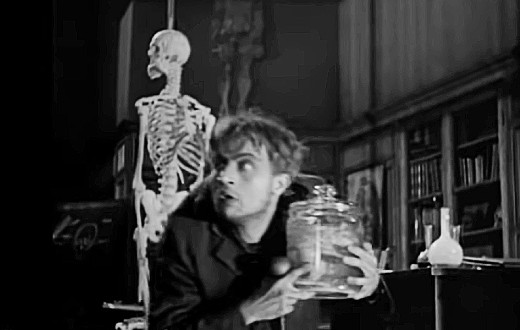 |
| In retrospect, Frankenstein should have run this important errand himself. |
And then there’s Donovan’s Brain (1953), which, while being kept alive in a laboratory, develops telepathic powers and possesses one of the lab scientists. The Brain That Wouldn’t Die (1962) picked up on the Donovan theme, featuring a whole head (and brain of course), played by Virginia Leith, that establishes a telepathic link with a Frankenstein-like creature in the basement laboratory that they share.
In a particularly gross-out variation, there’s the brains-as-delicacy theme exemplified by modern zombie movies. Contrary to popular belief, George Romero’s Night of the Living Dead (1968) and the Romero-directed sequels did not establish zombies’ predilection for eating brains. While Romero’s zombies can’t get enough of human flesh in general, it was Dan O’Bannon’s wonderfully comedic Return of the Living Dead (1985) that cemented the idea of zombies voraciously going after human grey matter. Since then it’s become a trope, with legions of fans speculating on why brains are such a special treat.
In yet another variation, The Brain from Planet Arous is a 30’s-style sci-fi pulp story brought to life in glorious black and white, featuring an alien menace that is all-brain with evil, glowing eyes.
Brain begins with a mysterious light descending from the heavens and finally exploding near a remote mountain range in the desert southwest. Nearby at a lab at the White Sands Proving Grounds, nuclear scientists Steve Marsh (John Agar) and Dan Murphy (Robert Fuller) notice that their instruments are picking up intermittent pulses of intense radiation from the area of Mystery Mountain.
The two men decide to drive out to the mountain to investigate, but not before having lunch with Steve’s fiancée Sally (Joyce Meadows) and her father John Fallon (Thomas Browne Henry). John warns the two that the daytime heat can be intense in the mountains, but they’re undeterred.
When they arrive at Mystery Mountain, a rock fall has blocked the road leading up to the mountain’s base, so they have to go the rest of the way on foot. They discover a cave that looks to have been recently blasted out of the rock, but there are no footprints or other signs of human activity.
Inside the cave, they encounter mysterious lights and sudden jumps in their Geiger counter readings. Suddenly, they’re confronted by a gigantic floating brain that zaps them with an intense light as Steve shoots wildly at it. Dan manages to get a shot off before succumbing to the radiation. The brain becomes semi-transparent, shrinks in size and enters Steve’s body as he lies unconscious on the cave floor.
 |
| Q: Why did the brain go running? A: It wanted to jog its memory. |
A week later, just as Sally is getting really worried about her fiancé's absence (!!), Steve shows up at her house with a suspicious story about not finding anything at the mountain, and Dan going off to Las Vegas for some R&R.
Sally’s suspicions mount when Steve becomes uncharacteristically and aggressively romantic to the point of physically assaulting her, only relenting when Sally’s dog George comes to her defense. To top things off, Steve is suddenly having seizures, which he attributes to a tooth acting up (uh-huh).
Sally’s father initially dismisses her concerns with an offhand “boys will be boys” attitude, but then agrees to go with her to Mystery Mountain to see if they can find any reason for Steve’s abrupt personality change.
They’re shocked when they find Dan’s burnt body in the cave, and amazed when confronted with yet another floating brain. This new alien introduces himself as Vol, a policeman from the planet Arous who is chasing Gor, a criminal who has taken over Steve’s body in order to further his mad plans for world domination.
The two earth people and the space policeman plot to stick close to Gor/Steve to figure out what he’s up to and to strike when he’s most vulnerable. Instead of inhabiting Sally or her Dad, Vol chooses the body of the dog to hide out in, because, well, George is loyal and friendly and spends almost as much time with Steve as the other two (okaaaaay….).
 |
| George the dog is a brain's best friend |
Brains from the planet Arous are apparently invulnerable when they’re in their semi-transparent transitory state or when they’re occupying a body, but every 24 hours they have to materialize and leave their hosts in order to recharge and suck in life-giving oxygen. That’s the only time Gor will be vulnerable, and Vol solemnly informs Sally that a blow to Gor’s fissure of Rolando is the only sure way to take him out. (Yes Virginia, the fissure of Rolando is a real thing.)
While Sally is waiting for a crack at Gor’s fissure (okay now, get your minds out of the gutter!), the alien occupier, unaware that anyone is on to him, is busy blowing planes out of the sky, frying inquisitive policemen, and demonstrating to incredulous government officials that his awesome telekinetic powers are more powerful than the atomic bomb. If the earthlings and Vol don’t stop him, Gor plans to subjugate the earth and use slave labor to build a space fleet to invade his home world!
In the first scene, the film reveals its pulp sci-fi roots when it shows Steve scurrying around the lab trying to make sense of the radiation readings, while Dan is seen relaxing in a chair reading a science fiction magazine (shades of The Big Bang Theory, where scientists spend most of their time reading comic books and role-playing!).
 |
| Dan catches up on the er, um, scientific literature. |
The sci-fi pulps of the early-to-mid 20th century were notorious for featuring lurid stories and cover art of bug-eyed monsters threatening curvaceous females. The Brain from Planet Arous is solidly in this camp, featuring a brain monster with glowing eyes and almost unlimited powers lusting after poor, confused Sally after he has infiltrated her fiancé’s body.
For an advanced brain creature that is supposedly all intellect, Gor is pretty inept at covering his tracks and posing as a human. When Gor/Steve suddenly shows up at Sally’s place, the best he can come up with is the dubious story of a futile search and Dan running off to Vegas. He doesn’t even bother to conceal Dan’s body, leaving it in the cave for Sally and her father to find.
Gor also seems unconcerned about blowing his cover by nearly ripping Sally’s clothes off in their first encounter. It’s understandable that a creature who has spent his whole life as nothing but pure intellect would be eager to try out his new body, but it seems a little strange for an evil mastermind to get distracted from his mission of world domination by falling for the charms of a fairly ordinary, albeit attractive, earth woman.
And charmed he most definitely is. Later, still pretending to be Steve, Gor drives Sally out to an overlook to take in the lights of the city sprawled out in the valley below. In an expansive mood, and bragging like a teenager trying to puff himself up in front of his best girl, he promises Sally the world… literally:
Gor: "That’s our world out there Sally, yours and mine."
Sally: "Really? All of it?"
Gor: "If you want it. … I can give it to you, believe me!"
It’s obvious that when occupying a body, Gor can access the memories and even some of the personality quirks of the host in order to pose as a human, but it’s not clear how much influence the suppressed host has on the occupier. Maybe a lot, given Gor’s infatuation.
Whatever the dynamic, the Gor/Steve hybrid is much more exciting than Steve alone. After experiencing her first kiss with the new, occupied Steve, Sally looks like she’s ready to pass out before exclaiming, “You never kissed me like that before!” Gor returns the favor later on when he muses that “She gives me a very strange, very new elation!” If only Gor wasn’t so dead set on conquering the world, they might have made a wonderful threesome.
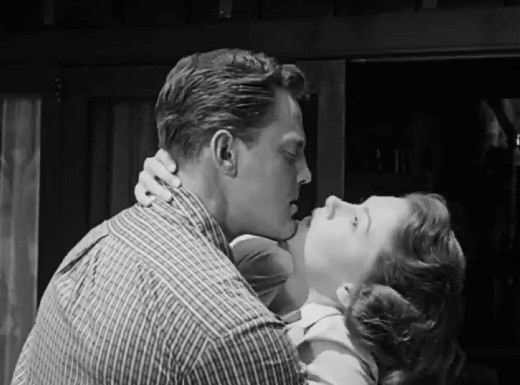 |
| Gor has a lot of catching up to do after a lifetime without a body. |
The whole conquering the world thing also raises a question or two. It appears that Gor has deliberately chosen to land at Mystery Mountain because of its nearness to the White Sands nuclear testing grounds. Additionally, inhabiting the body of Steve, a nuclear scientist, will get him access to the inner sanctum of the country’s’ nuclear defense establishment.
But for some reason he just sits in the cave he’s blasted out of the mountain and waits for Steve to come to him (how he knows it will be a valuable nuclear scientist and not just some ordinary lunkhead is another mystery).
To add insult to ridiculousness, Gor doesn’t want access to the nuclear testing facility to appropriate the weapons, but rather to demonstrate to the gathered officials that his telekinetic powers are far more powerful than their measly atom bombs, and that they have 24 hours to assemble representatives from the world’s major powers to hear his ultimatum.
If I were Gor, I’d cut out the middleman (sorry Steve), fly directly to Washington D.C., obliterate something showy, like the Washington monument, and then issue my ultimatum on national TV. But I guess Gor didn’t want to be seen as some low-grade knock-off of the venerated Klaatu. And he wouldn’t have been able to partake of some of those, ahem, earthly pleasures that floating brains don’t get to experience very often.
But, let’s face it, all this nitpicking violates the first law of watching so-bad-they’re-good sci-fi movies: just turn off your brain and enjoy the show.
 |
| Steve tries to do the math in his head: Gor in a solid, vulnerable state + the fissure of Rolando + a sharp axe = ? |
The Brain from Planet Arous is cheap, even by ‘50s sci-fi standards, but you’ve got to admire the audacity of trying to make a movie about evil brains and world domination on a budget so tight that you can almost hear the screech of the producers being separated from their nickels and dimes as you watch it unfold.
Speaking of producers, Jacques Marquette, who was best known as a cinematographer, but who started out producing low-budget sci-fi movies like The Brain from Planet Arous and that most iconic example of ‘50s sci-fi cheese, Attack of the 50 foot Woman, was interviewed by B movie historian Tom Weaver about his early gigs. Marquette good naturedly addressed the inspiration for the story and the cost-cutting involved in the production:
Where did your idea for Brain come from?
It was a story which I had sort of halfway stolen from Amazing Stories, I used to read that, Astounding Science Fiction, all of those -- I loved science fiction. One of them ran a story about a guy on the beach in the summer, and this thing came out of the ocean, went up into his foot and took him over.
…
What was your budget on Arous?
The budget, as I recall, was about fifty-eight thousand dollars. I did all the optical effects in the camera; otherwise, it would have cost probably five hundred dollars for one effect.
…
What do you remember about the brain prop?
We told the people who were going to make it what we wanted, and that we wanted lights inside. It was made of plastic and held up with wires. Later on, after we finished the picture, my kids got a hold of it and put on a show. They’d get other kids together, charge ‘em five cents and put on a show with the brain in there. [laughs].
[Weaver, Tom. Attack of the Monster Movie Makers, McFarland, 1994; pp. 197-198]
In the interview Marquette also mentions the silver-coated contact lenses that star John Agar wore for the scenes in which Steve, under Gor’s control, demonstrates his awesome powers. In yet another Weaver interview, Agar acknowledged enjoying the opportunity to play a kind of Jekyll-and-Hyde role, but the contact lenses were a big challenge:
“I’ll tell you one thing, that picture was a very painful experience for me. When that alien being took over my body, they inserted these full contact lenses in my eyes. They’d painted ‘em silver and they forgot that that doggone paint would chip off. Every time I blinked, some of that silver would come off the lens and it was like having sand in my eyes.”
[Weaver, Interviews with B Science Fiction and Horror Movie Makers: Writers, Producers, Directors, Actors, Moguls and Makeup, McFarland, 1988; p. 10]
Yikes! Despite the pain of having flecks of silver paint in his eyes, Agar gives it his all, laughing maniacally in classic melodramatic fashion as he terrorizes the world.
 |
| Prerequisites for world domination: Awesome telekinetic powers - check Maniacal laugh - check Rad silver-coated contact lenses - ouch! |
In the early part of his career Agar snagged roles in several prestige A pictures -- John Ford’s Fort Apache (1948) and She Wore a Yellow Ribbon (1949), and Allan Dwan’s Sands of Iwo Jima (1949) prominent among them -- but he will forever be remembered for grade-B sci-fi cheese like The Brain from Planet Arous. At best a middling actor, his ultimate career path from A pictures to Bs and even Zs (e.g., Zontar: The Thing from Venus, 1967 and Curse of the Swamp Creature, 1968) was perhaps a foregone conclusion. Later on, he expressed no remorse about being associated with those pictures, and was just grateful for the opportunity to entertain people (see my write up of The Hand of Death elsewhere on the blog).
Gor’s and Steve’s main squeeze, Joyce Meadows, made just a handful of films, but like many actors of her generation, she kept busy making guest appearances in every nook and cranny of TV from the ‘50s through the ‘90s.
Director Nathan Juran is a sci-fi movie hall of famer, with a number of classics and near-classics on his resume: The Deadly Mantis (1957), Twenty Million Miles to Earth (1957), Attack of the 50 Foot Woman (1958), The 7th Voyage of Sinbad (1958), and First Men in the Moon (1964). Toward the end of his career, he directed multiple episodes of such popular Irwin Allen TV shows as Voyage to the Bottom of the Sea, The Time Tunnel, Lost in Space and Land of the Giants.
As for the merits of The Brain from Planet Arous, I’ll let yet another venerable B movie historian, Bill Warren, have the final say:
“In doing research for this film, I was startled to find that several reviews called the plot ‘conventional.’ Though the film is conventionally made, the premise is truly bizarre, anything but ‘conventional.’ The idea is too grandiose for the budget level, and it’s silly throughout, but at least it’s imaginative and unusual.”
[Warren, Keep Watching the Skies! American Science Fiction Movies of the Fifties, Volume II, McFarland, 1986; p. 33.]








